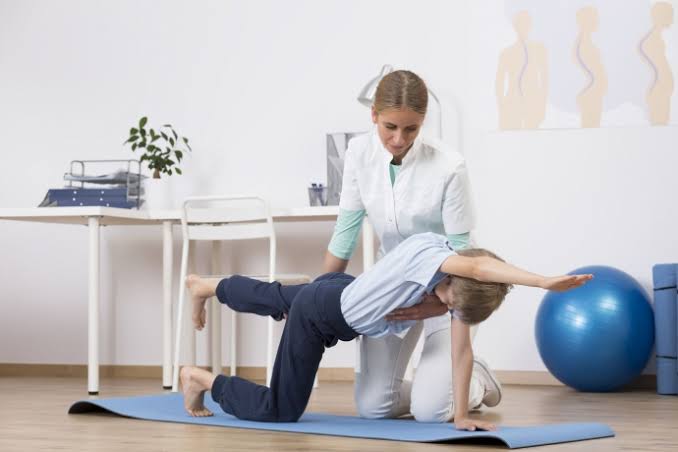Physiotherapists are trained professionals who help those who are injured or in pain restore their quality of a life. You’ll find these experts working in medical centers, public schools, clinics, and even in your home!
What they do involves more than a bending a few joints and massaging a few muscles. Their extensive knowledge gives them the expertise to utilize a wide range of treatments to address their patients’ unique needs.
Here are six different types of physiotherapy treatments used in rehabilitation:
1. Range of Motion (ROM) Exercises
Range of motion exercises are used to improve joint function and indicate how far you can move your joints in different directions. These exercises aid in moving each joint through its full range of motion.
Physiotherapists use devices to measure range of motion such as a Goniomater and Inclinometer that measure the angles from the axis of the joint. Tape measures are also used to measure the lumbar (back) range of motion.
There are three types of range of motion exercises that physical therapists use:
- Passive Range of Motion: Movement is applied to a joint by the physiotherapist using a passive motion machine. The joint is completely relaxed and outside force moves the body parts such as the leg or the arm throughout the available range.
- Active Range of Motion: Moving the joint is done entirely by the patient with no outside force.
- Active Assist Range of Motion: The joint receives partial assistance from an outside force.
2. Soft Tissue Mobilization
Soft tissue mobilization includes a wide variety of exercises using hands-on techniques on your muscles, ligaments, and fascia to break adhesions and optimize muscle function.
Adhesions refer to your body’s attempt to heal a soft tissue injury through a process of inflammation that pulls new tissue against one another which can trigger pain such as spinal pain, pelvic pain, and shoulder pain.
The goals of soft tissue mobilization also include improving range of motion, lengthening muscles and tendons, reducing swelling, decreasing pain, and restoring functionality. This can be done at clinics such as https://www.greymethod.ca/.
A licensed physiotherapist will use their hands to push, pull, and knead your muscles, ligaments, tendons, and nerves to a achieve these goals. Some techniques of soft tissue mobilization include sustained pressure, direct oscillations (pushing on the restricted tissue), parallel mobilization (pushing along the seams of the muscle), and friction massage.
Through their education and training, physiotherapists have a vast body of knowledge when it comes to performing these techniques to help patients reach their functional goals.
3. Electrotherapy
Not to be confused with electroshock therapy sometimes used in psychiatric treatment, electrotherapy works by using electrical signals to interfere with the transmission of neural pain signals into the brain.
In physical therapy, this technique is used in the area of treatment to block acute or chronic pain, especially when conventional medicines are not effective.
The electrical currents involved in electrotherapy can also speed healing when it comes to damaged tissue.
When it comes to physiotherapy, you’ve probably heard of something called a “TENS” machine. This stands for “Transcutaneous Electrical Nerve Stimulation” and is one of the electrotherapy assistive devices a physical therapist will use to treat conditions such as arthritis, back pain, labor pain, and nerve-related pain.
4. Cryotherapy and Thermotherapy
In the world of physical therapy, cryotherapy and thermotherapy are simply fancy terms that describe therapies involving heat and cold.
Thermotherapy uses hot packs to treat symptoms of acute or chronic pain by widening the blood vessels and increasing blood flow to the injured area. It relaxes the muscles, decreases spasms, and reduces stiffness in the joints.
Thermotherapy is commonly used to treat conditions such as neck pain, tensed muscles, and joint stiffness.
Cryotherapy, on the other hand, involves applying cold to the area to reduce the amount of fluid flowing to the tissues. This slows the release of pain-causing chemicals and inflammation to reduce swelling and facilitate healing.
Cold therapy is most commonly used for conditions such as twisted knees, sprained ankles, shoulder pain, and acute muscle strain.
5. Kinesio Taping
Kinesiology tape is a stretchy tape used by physiotherapists and it’s designed to mimic the skin’s elasticity to facilitate full range of motion. When the tape is applied to the body, it recoils slightly and gently lifts the skin to create a microscopic space between the skin and the tissues underneath it.
This lifting effect eliminates compression on pain receptors, blood, and lymph vessels to allow the vessels to open. This enhances blood flow and movement of lymph fluid to encourage healing. It also decreases pressure on pain receptors to reduce pain and keeps the joints and tissues in the desired position.
There are multiple ways kinesiology tape can be applied depending on the type of injury and the professional physiotherapy applying the tape:
- Recoiling: The stretch of the tape is used to give feedback on body positioning.
- Holding: The tape aligns tissue into the desired position.
- Lifting: The tape reduces compression to increase blood flow, reduce swelling, and minimize pain.
- Pressure: The tape is applied to increase the stimulation of tissues over a particular ligament or tendon.
- Spring: The tape is used to assist or limit motion around a joint.
- Channeling: Kinesiology tape is used to decrease pressure over lymph ducts and encourage lymph flow.
6. Therapeutic Ultrasound
Ultrasounds are used for more than generating images of the womb during pregnancy. Physiotherapists used diagnostic ultrasounds to capture images of organs and other soft tissues.
This tool is used to aleviate chronic pain and help with tissue healing for conditions such as carpal tunnel syndrome, shoulder pain, tendonitis, ligament injuries, and joint tightness.
Therapeutic ultrasounds are used in two different ways:
Deep Heating: Therapeutic ultrasound can be used to provide deep heating to soft tissues in order to increase blood circulation, promote healing, and decrease pain. This form of therapeutic ultrasound may also be used to improve muscle flexibility and restore full range of motion.
Cavitation: Ultrasound energy can be used to cause quick contraction and expansion of gas that may bubble (cavitation) around injured tissue and speed healing.
Physiotherapy for Rehabilitation and Pain Management
Physiotherapy in and of itself is a wonderful tool to help you overcome physical injuries as well as manage chronic pain. If you have any questions about physiotherapy techniques or how to book an appointment, be sure to contact a clinic close to you.


